| Hours | Shop | |
|---|---|---|
| transaction_id | ||
| 7 | 12 | Shop A |
| 11 | 15 | Shop A |
| 19 | 14 | Shop A |
| 32 | 16 | Shop A |
| 33 | 19 | Shop A |
ECON 0150 | Economic Data Analysis
The economist’s data analysis pipeline.
Part 1.4 | Panel Data
Panel Data: Long Format vs Wide Format
Panel data comes in one of two formats.
Panel Data in Long Format uses lists each entry as a row, using a column (eg. Shop) to record the group.
Panel Data: Long Format vs Wide Format
Panel data comes in one of two formats.
Panel Data in Wide Format uses lists each group as a row, using a column to record each entry.
| 1999 | 2019 | |
|---|---|---|
| Code | ||
| AUT | 8.430589 | 7.925747 |
| BGR | 2.652661 | 3.638313 |
| HRV | 4.480790 | 5.623266 |
| CYP | 3.477888 | 5.615070 |
| CZE | 3.255587 | 4.739563 |
Hiring a Barista
Use Coffee_Sales_Receips.csv to help inform where to hire a barista.
- You manage three coffee shops and are considering where to hire a new barista.
- You have a dataset containing information about the transactions taking place at all three coffee shops throughout the day.
- Lets consider how to use this data to inform our decision.
Hiring a Barista
Q. Which coffee shop is the busiest?
Hiring a Barista: Bar Graphs Compare Shops
Q. Which coffee shop is the busiest?
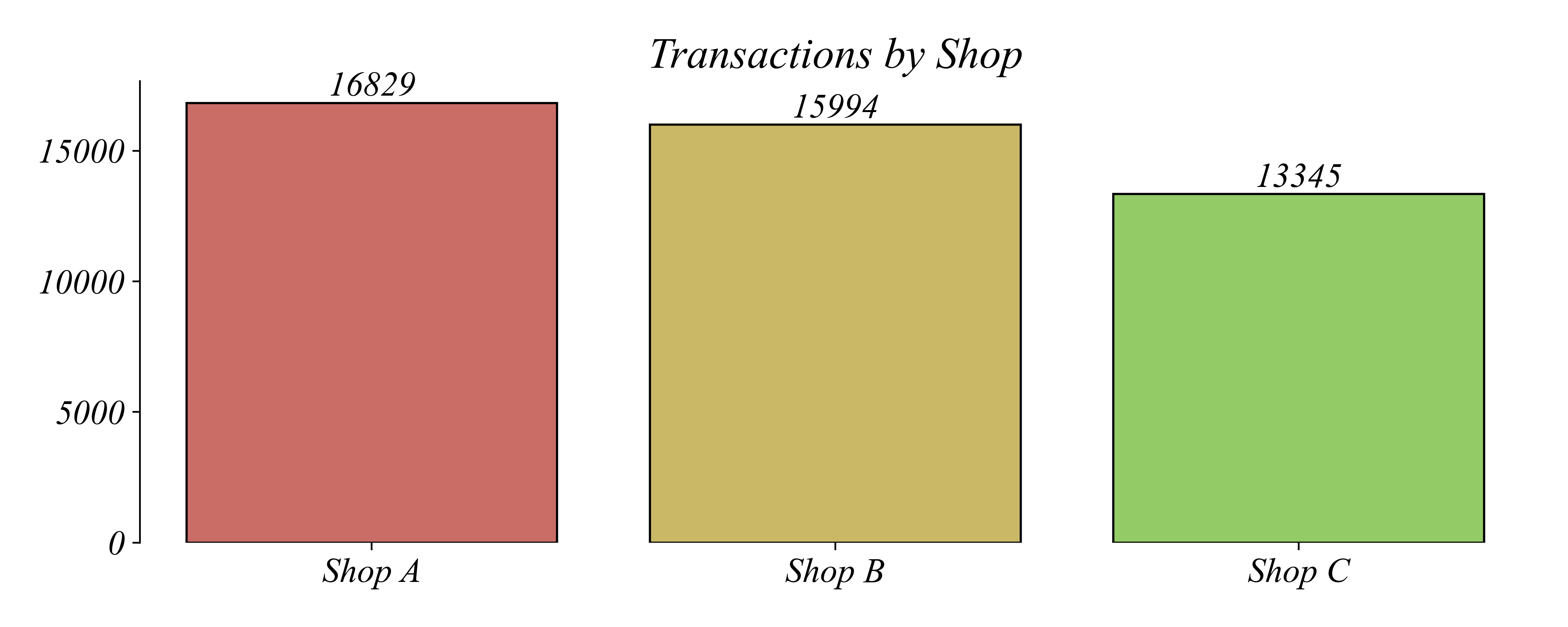
> a bar chart makes it easy to compare shops’ busyness
Hiring a Barista
Q. What time of day is the busiest?
Hiring a Barista: Histograms Can Compare Times
Q. What time of day is the busiest?
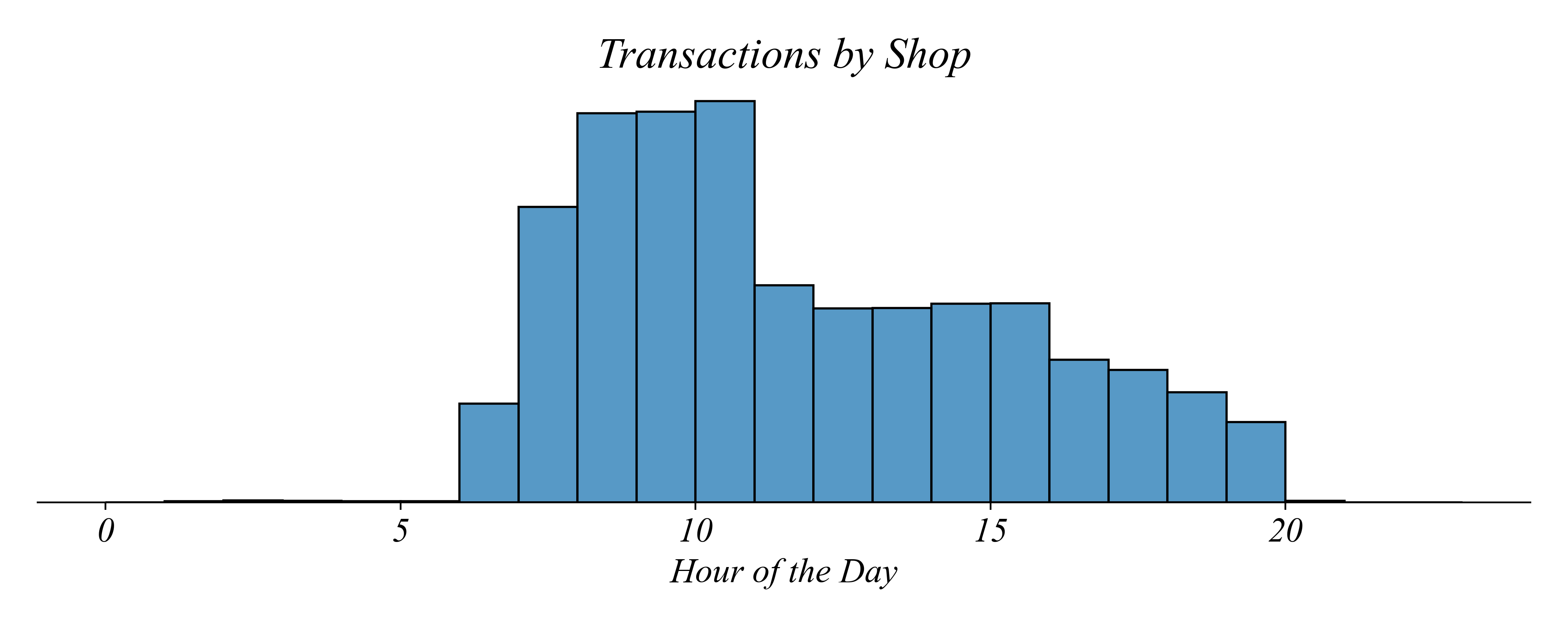
> a histogram makes it easy to compare transactions by time of day
> does this mean the morning shift at Shop A is the busiest?
Hiring a Barista
Q. Which shift is the busiest?
Hiring a Barista: Transactions by Shop
Q. Which shift is the busiest?

> an overlaid histogram can show all three groups
> does this show the data clearly?
Hiring a Barista: Transactions by Shop
Q. Which shift is the busiest?
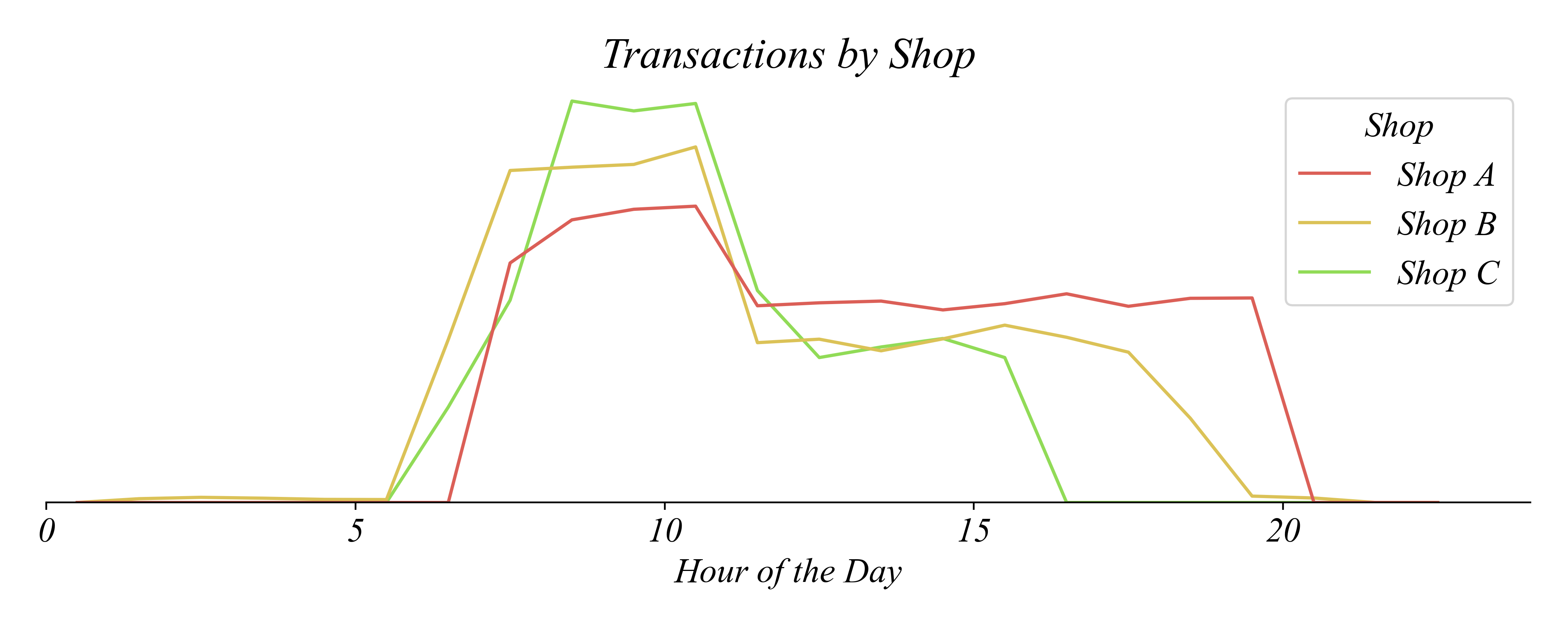
> instead, lets use a line graph
Part 1.4 | Panel Data Using Line Graphs
Summary
- Categorical variables and continuous variables can give us different views of the same data.
- We can visualize both views one the same graph.
- Line graphs help simplify the visualization of multiple categories.
Exercise 1.4 | Coffee Shop Transactions
Use Coffee_Sales_Receips.csv to help inform where to hire a barista.
| Hours | Shop | |
|---|---|---|
| 0 | 12 | Shop A |
| 1 | 15 | Shop A |
| 2 | 14 | Shop A |
| 3 | 16 | Shop A |
| 4 | 19 | Shop A |
> you’ll see a few more columns in your dataset
> this is Long-Format Panel Data: transactions are all in the same column
Exercise 1.4 | Bar Chart
Use Coffee_Sales_Receips.csv to help inform where to hire a barista.

Exercise 1.4 | Histogram
Use Coffee_Sales_Receips.csv to help inform where to hire a barista.

Exercise 1.4 | Multi-Histogram
Use Coffee_Sales_Receips.csv to help inform where to hire a barista.

Exercise 1.4 | Count Hourly by Shop
Q. Which shift is the busiest?
# Create hourly counts by shop
hourly_counts = sales.groupby(['Shop', 'Hours']).size().reset_index(name='Count')| Shop | Hours | Count | |
|---|---|---|---|
| 0 | Shop A | 7 | 1383 |
| 1 | Shop A | 8 | 1632 |
| 2 | Shop A | 9 | 1693 |
| 3 | Shop A | 10 | 1711 |
| 4 | Shop A | 11 | 1136 |
Exercise 1.4 | Multiple Line Graph
Q. Which shift is the busiest?
# Multiple-Line Graph
sns.histplot(sales, x='Hours', hue='Shop', bins=range(0,24,1), element='poly')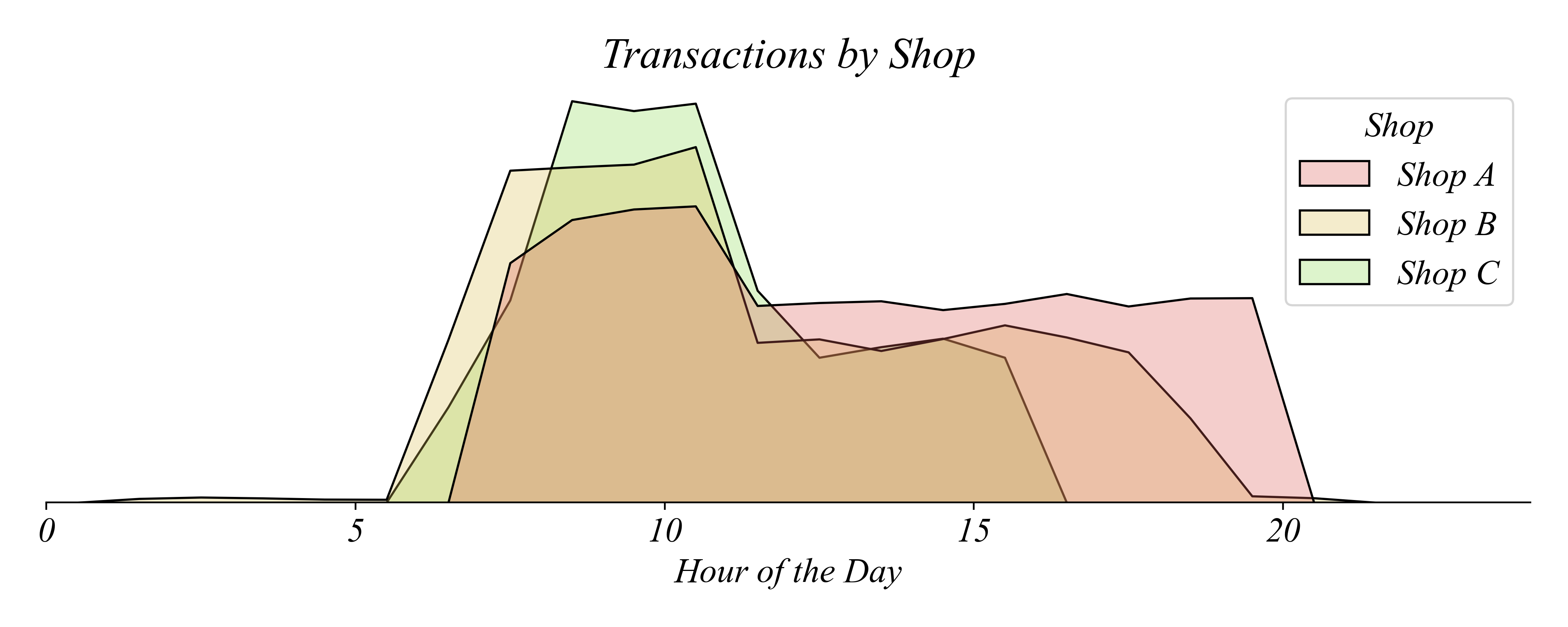
Exercise 1.4 | Multiple Line Graph
Q. Which shift is the busiest?
# Multiple-Line Graph
sns.histplot(sales, x='Hours', hue='Shop', bins=range(0,24,1), element='poly', fill=False)
Panel Data: Coffee Consumption Per Capita
Is the world drinking more coffee?
Lets examine whether the world is drinking more coffee today than in the 1990s.
- Data:
Coffee_Per_Cap.csv
Panel Data: Coffee Consumption Per Capita
Is the world drinking more coffee?
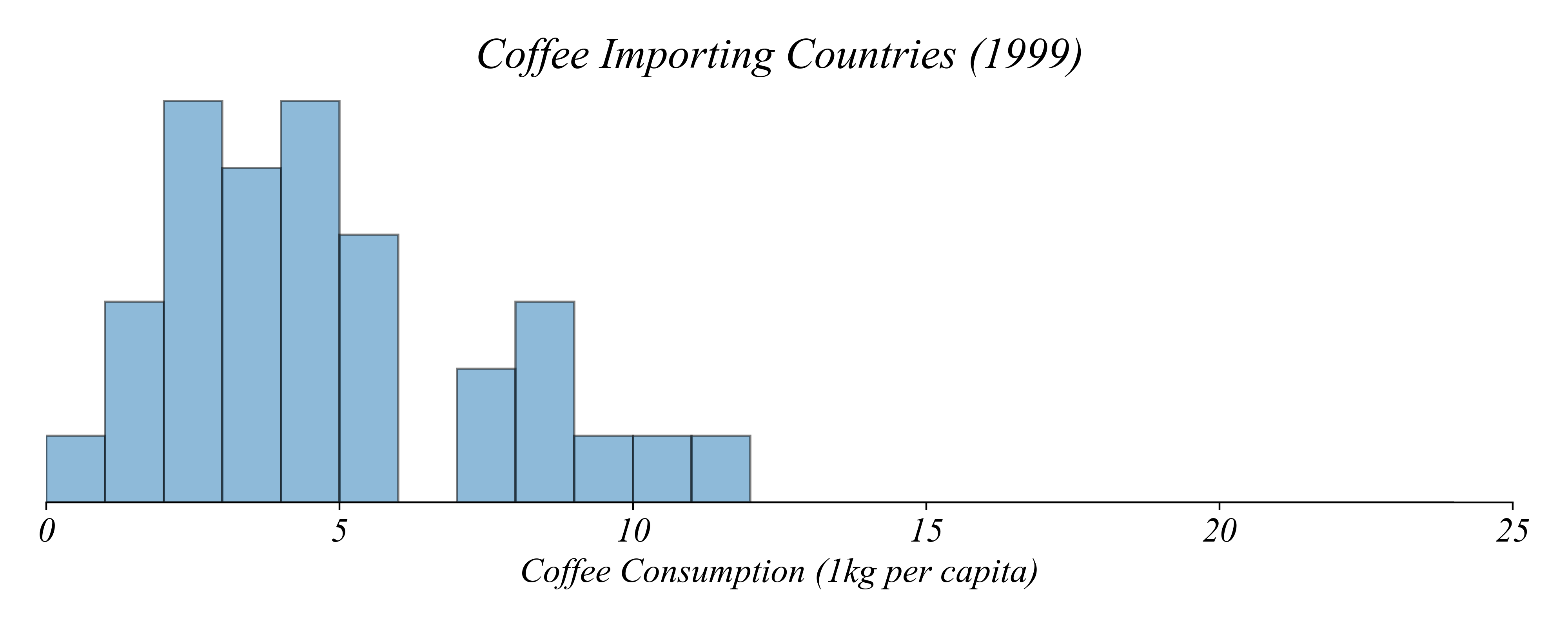
> compared to what…?
Panel Data: Coffee Consumption Per Capita
Is the world drinking more coffee?

> this is still pretty unclear: histograms aren’t great for comparison
> lets use a multi-boxplot
Panel Data: Multi-Boxplots
Is the world drinking more coffee?

> this is better: it looks like the distribution is shifted higher!
> lets examine the years in between to see how the distribution evolved
Panel Data: Multi-Boxplots
Is the world drinking more coffee?
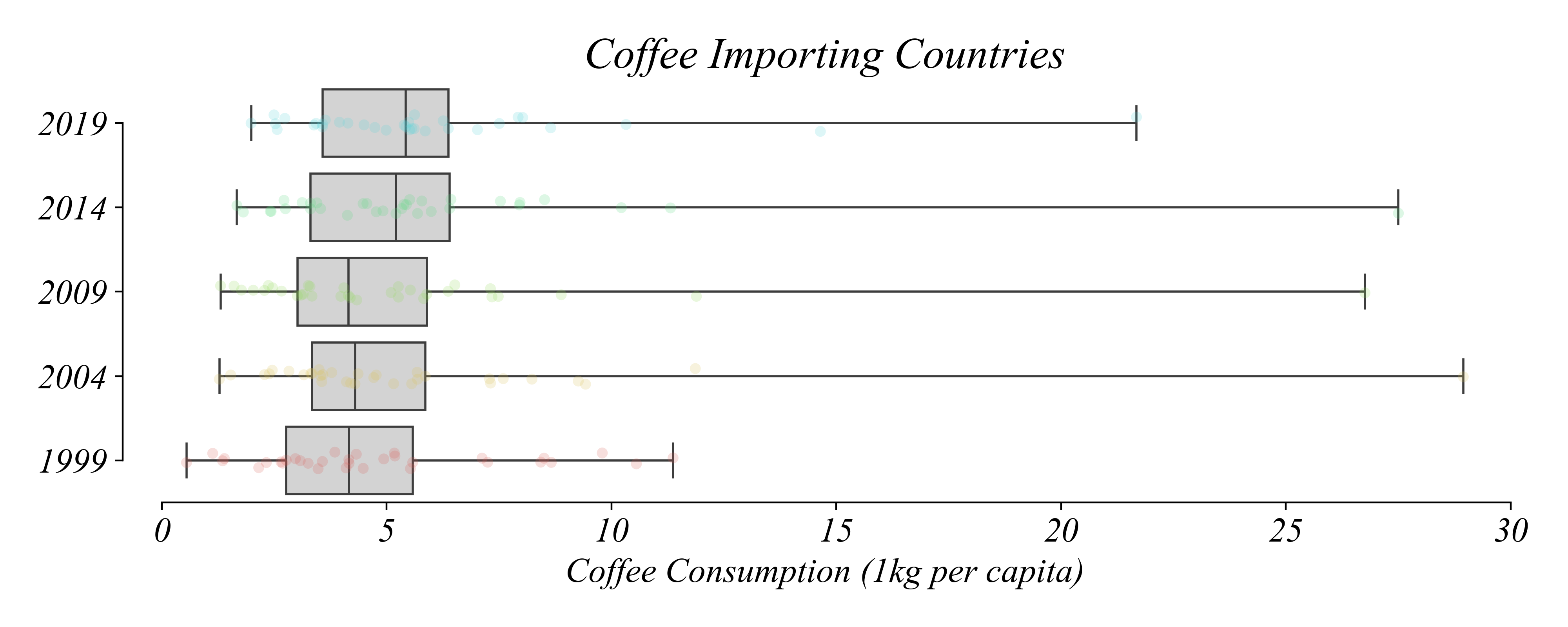
> lets ask some smaller more focussed questions
Panel Data: Multi-Boxplots
Which years show at least half consuming less than 5 kg per cap?
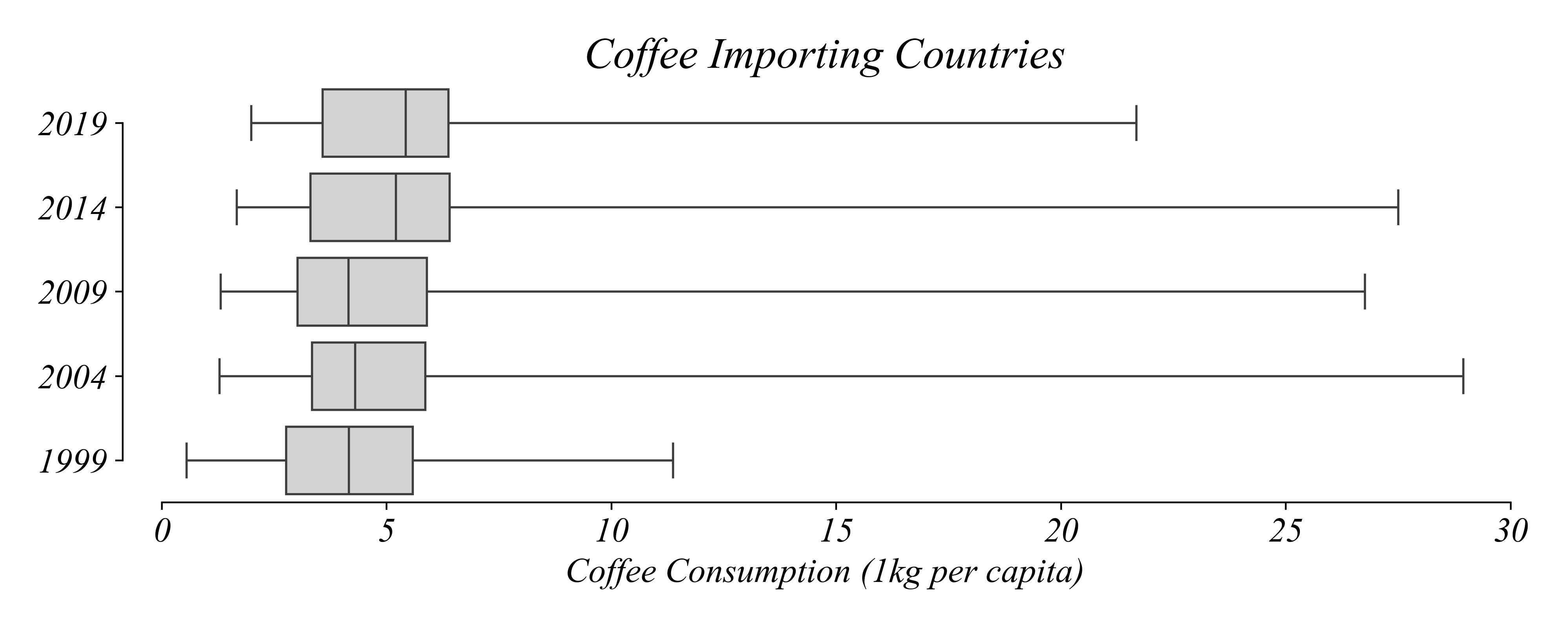
Panel Data: Multi-Boxplots
Which years show at least half consuming less than 5 kg per cap?
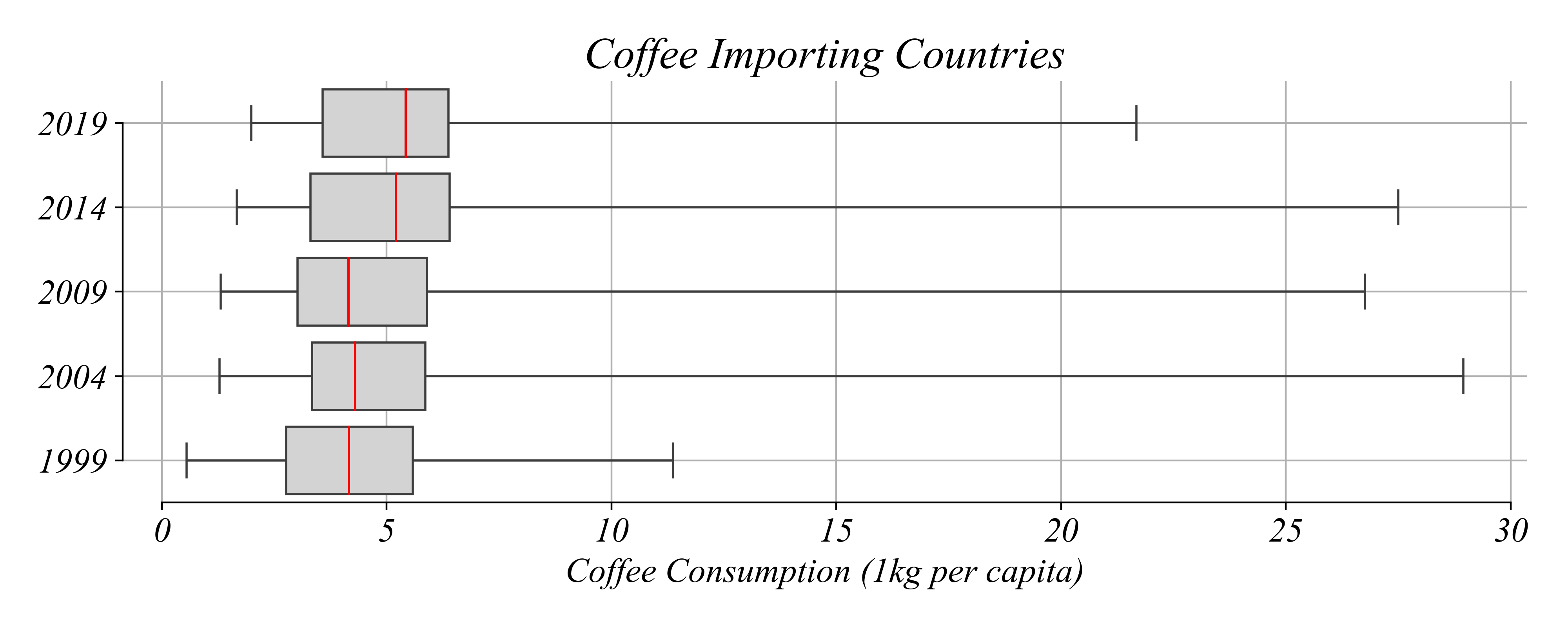
> focus on the medians
Panel Data: Multi-Boxplots
Which years show at least half consuming less than 5 kg per cap?
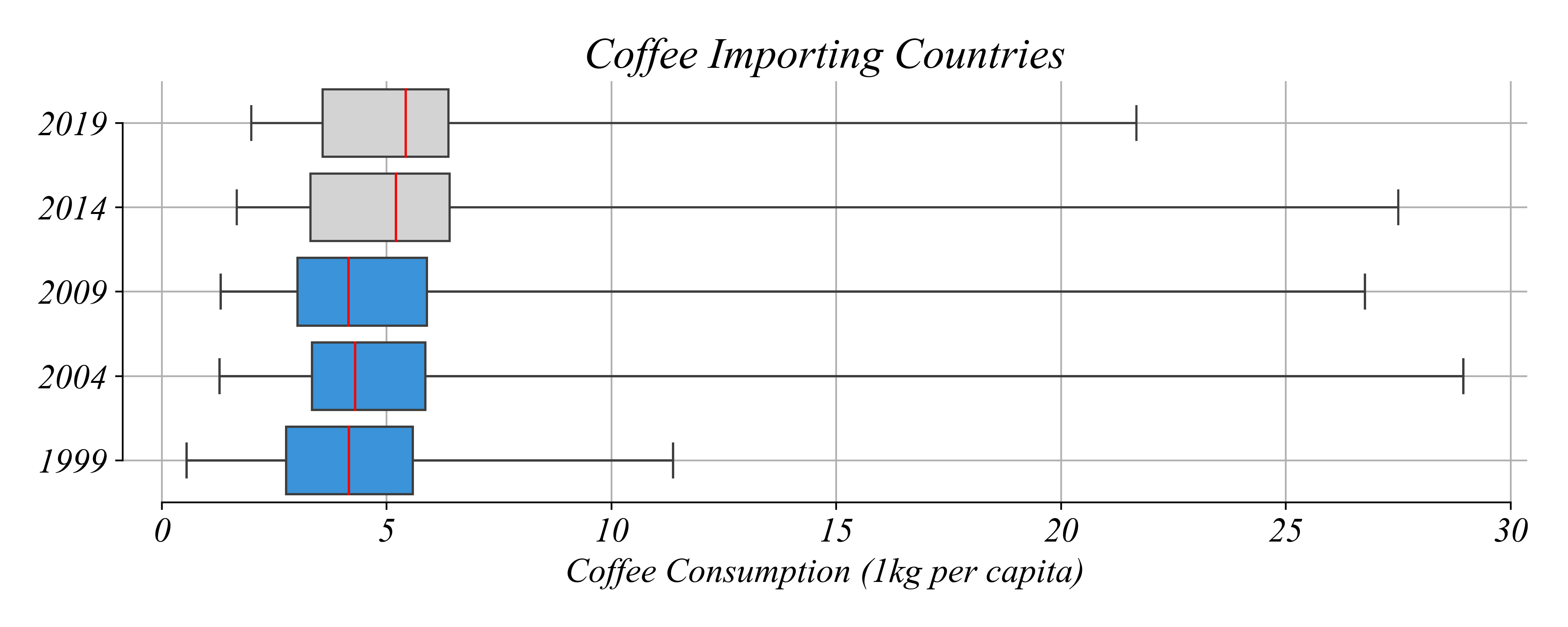
> … when the median is above 5 kg per cap
Panel Data: Multi-Boxplots
Which years saw the largest jump in the median?

> … a little difficult to see
Panel Data: Multi-Boxplots
Which years saw the largest jump in the median?
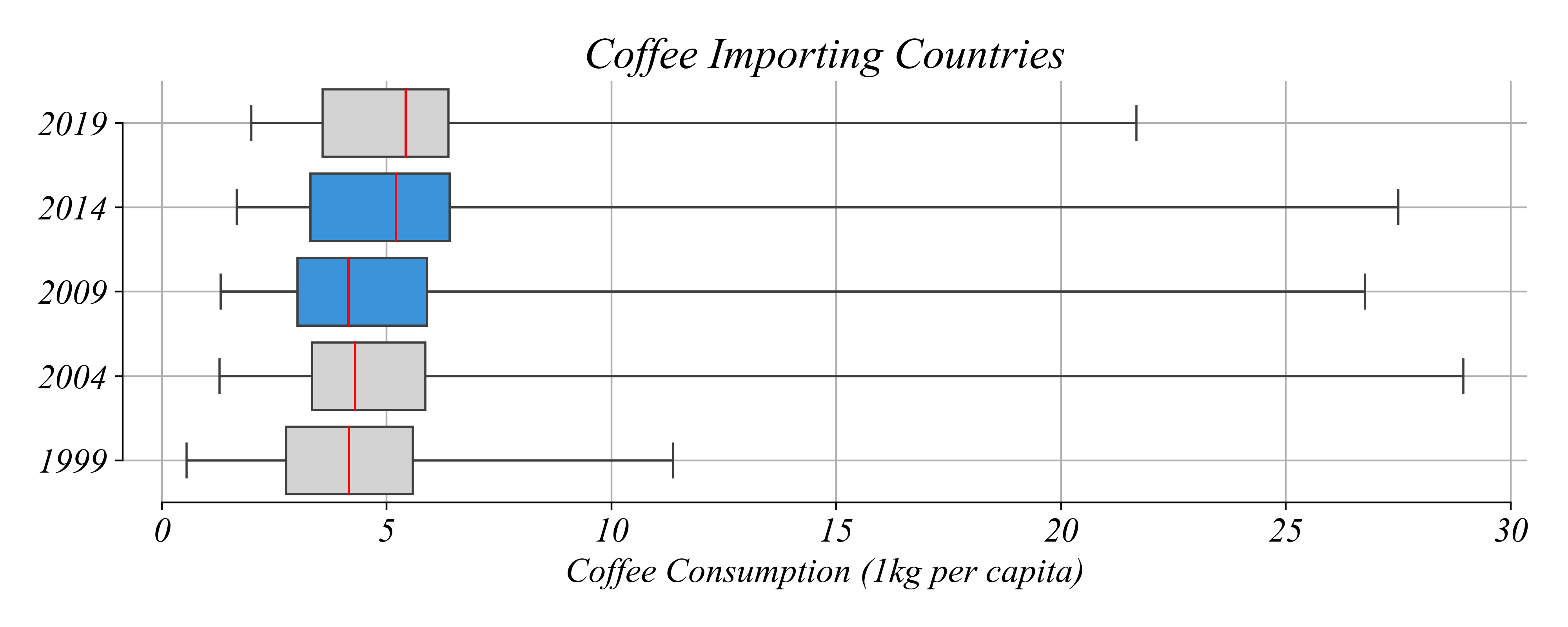
> … a little difficult to see
Panel Data: Multi-Boxplots
Is the country with the lowest consumption consuming more today?

Panel Data: Multi-Boxplots
Is the country with the lowest consumption consuming more today?
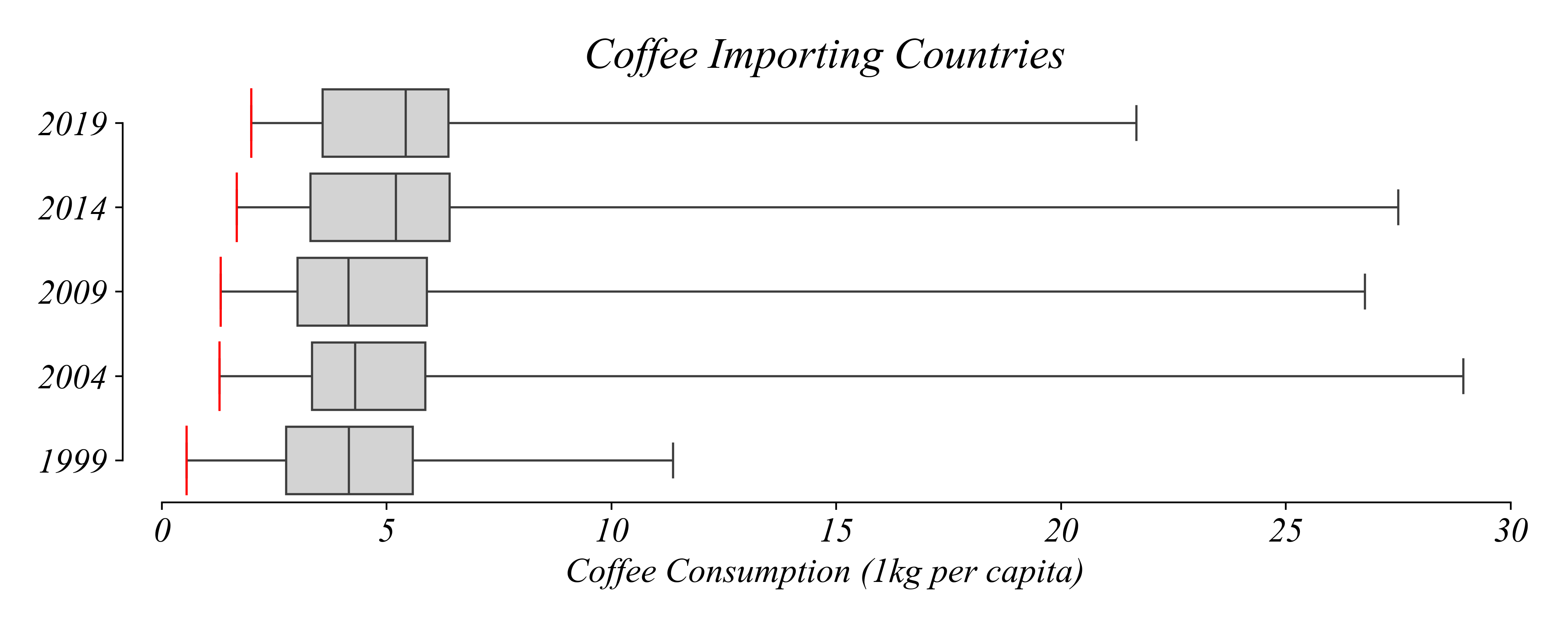
> focus on the minimums
> yes!
Panel Data: Multi-Boxplots
What patterns do we observe about the maximums?
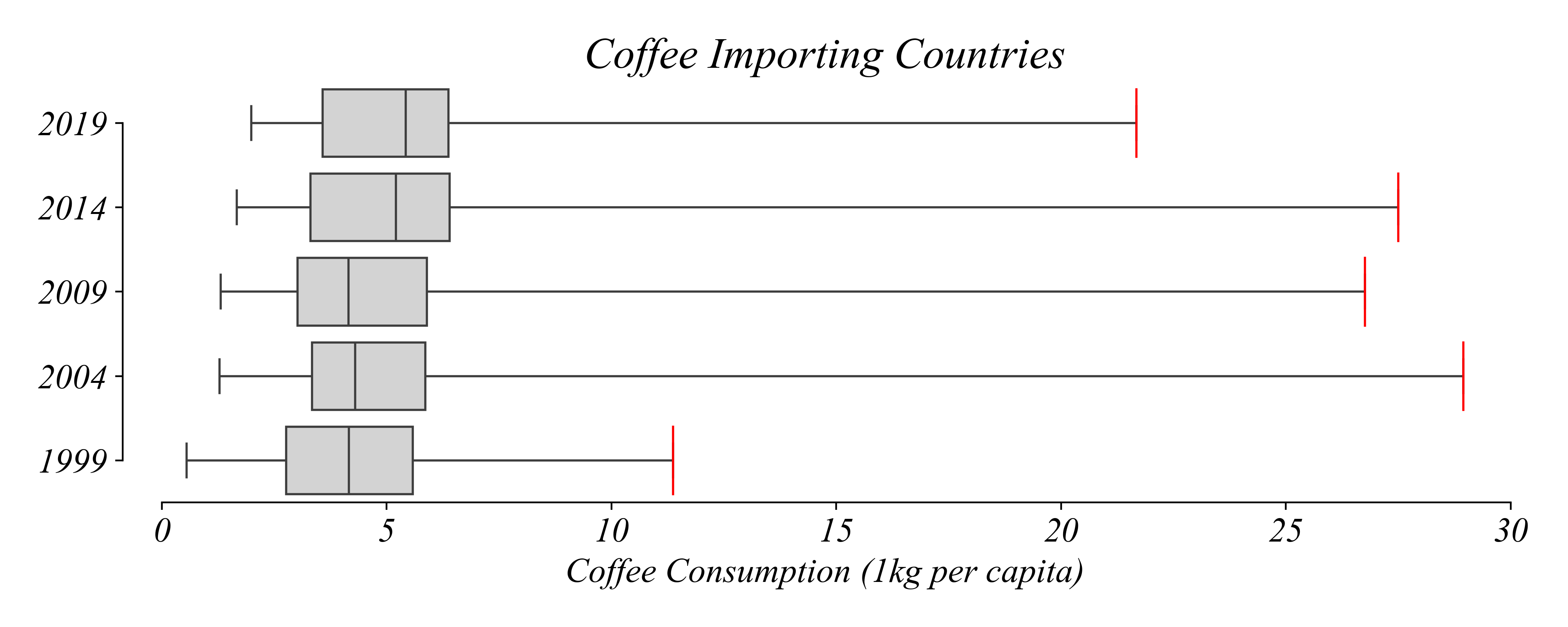
> same with the maximums
Panel Data: Multi-Boxplots
Which years did more than 25% consume less than 5 kg?

Panel Data: Multi-Boxplots
Which years did more than 25% consume less than 5 kg?
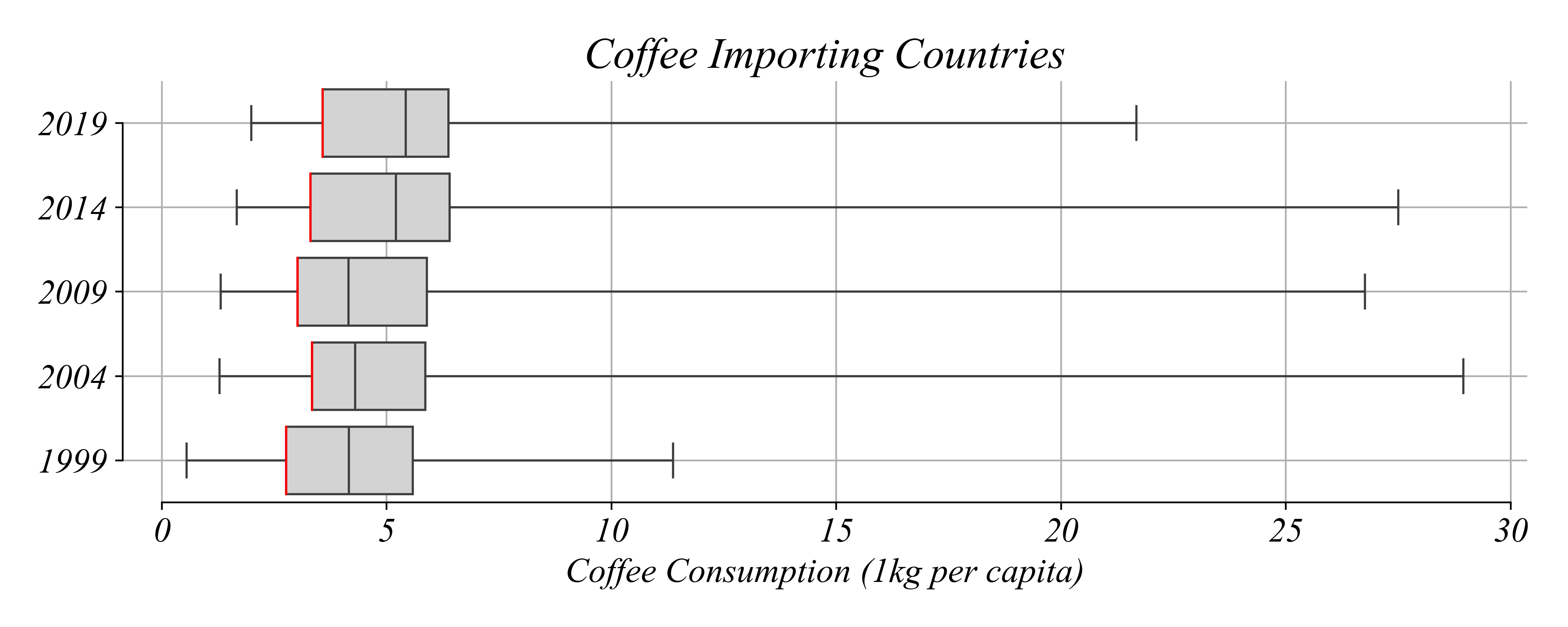
> look at the 25%
Panel Data: Multi-Boxplots
Which years did more than 25% consume less than 5 kg?

> look at the 25% and compare it to 5 kg per cap
Panel Data: Multi-Boxplots
Which years did more than 25% consume less than 5 kg?

> all of them
Panel Data: Multi-Boxplots
Which year saw the greatest difference between any two countries?

> look at the range
Panel Data: Multi-Boxplots
Which year saw the greatest difference between any two countries?
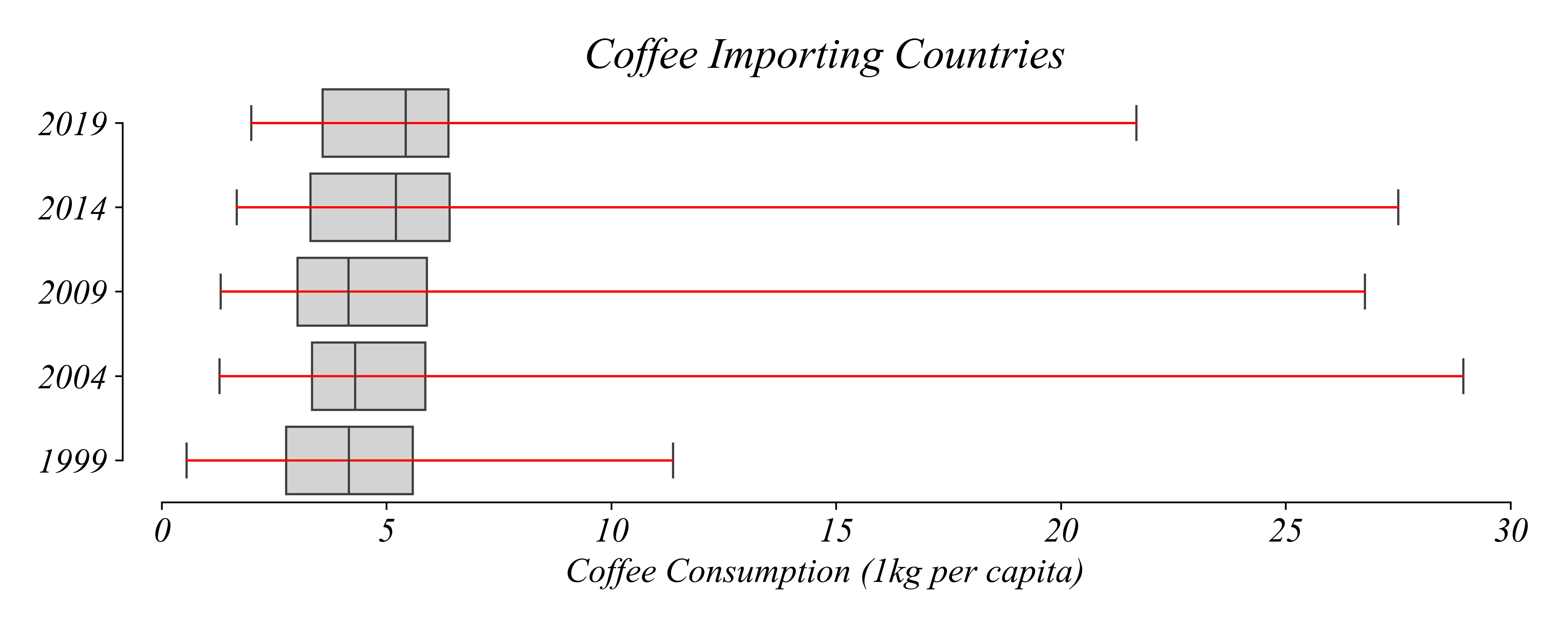
> look at the range
Panel Data: Multi-Boxplots
Which year saw the greatest difference between any two countries?

> look at the range and select the largest
Exercise 1.4 | Multi-Boxplots
Is the world drinking more coffee?
We’re going to use a set of boxplots to visually compare across years the distributions of coffee consumption per capital among coffee importing countries.
- Data:
Coffee_Per_Cap.csv
| Code | 1999 | 2009 | 2019 | |
|---|---|---|---|---|
| 0 | AUT | 8.430589 | 6.371562 | 7.925747 |
| 2 | BGR | 2.652661 | 3.296419 | 3.638313 |
| 3 | HRV | 4.480790 | 5.100831 | 5.623266 |
| 4 | CYP | 3.477888 | 4.050500 | 5.615070 |
| 5 | CZE | 3.255587 | 3.016104 | 4.739563 |
> this is Wide-Format Panel Data: each year is in a separate column
Exercise 1.4 | Multi-Boxplots
Is the world drinking more coffee?
With wide-format panel data seaborn looks a little different.
# Wide Format Multi-Boxplot
sns.boxplot(percap[['1999','2004','2009','2014','2019']], orient='h', whis=(0, 100))
Panel Data: Multi-Boxplots
In which year did most countries increase their coffee consumption?

> not visible in the figure!
Panel Data: Relationships Between Years
How many countries increased their coffee consumption between 1999 and 2019?

> also not visible with this figure!
Panel Data: Relationships Between Years
How many countries increased their coffee consumption between 1999 and 2019?

> better, but this figure still doesn’t let us keep track of countries between years…
Panel Data: Relationships Between Years
How many countries increased their coffee consumption between 1999 and 2019?
Panel Data: Relationships Between Years
How many countries increased their coffee consumption between 1999 and 2019?
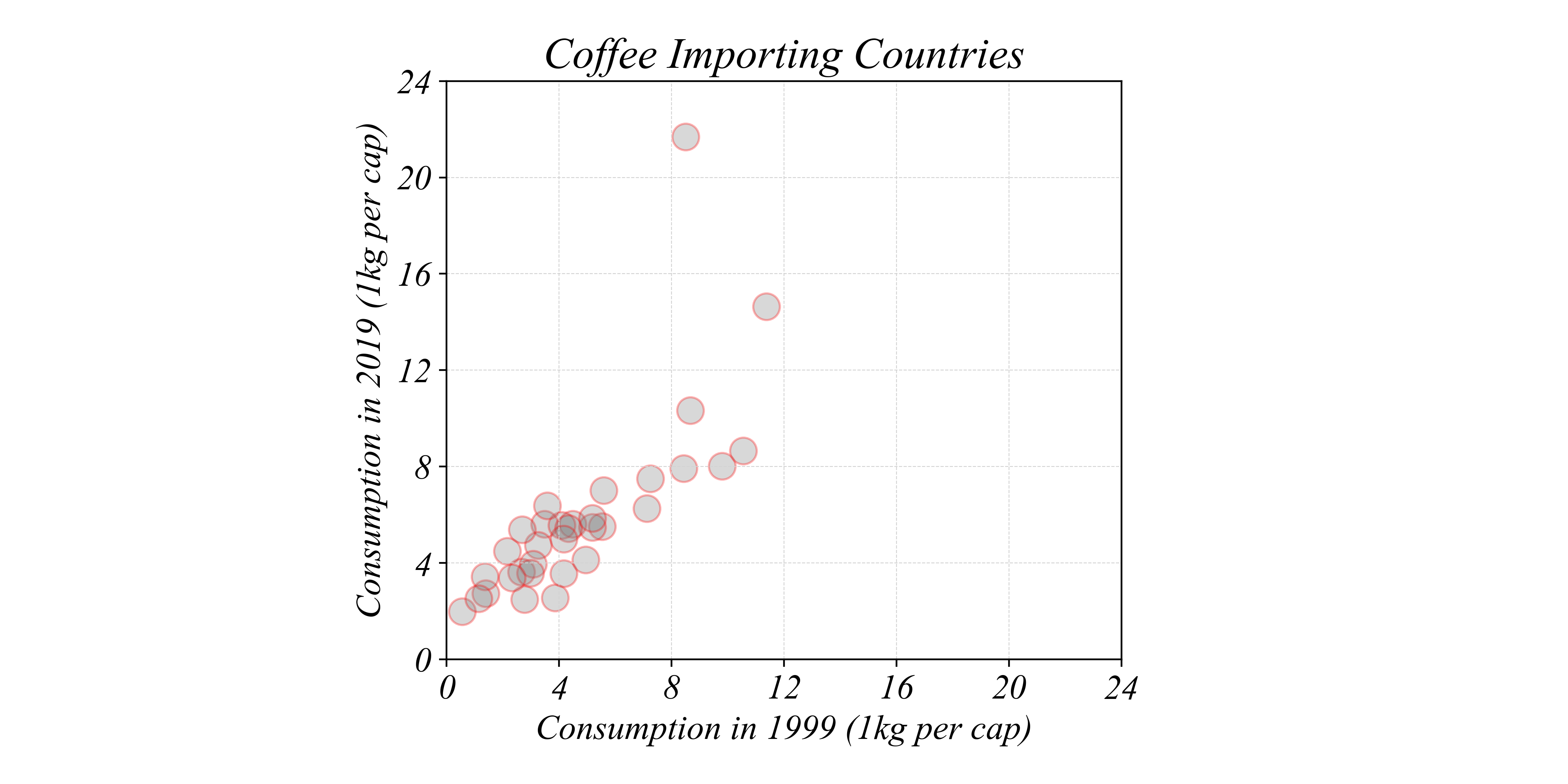
> a scatter plot can visualize changes between two points in time
Panel Data: Relationships Between Years
How many countries increased their coffee consumption between 1999 and 2019?
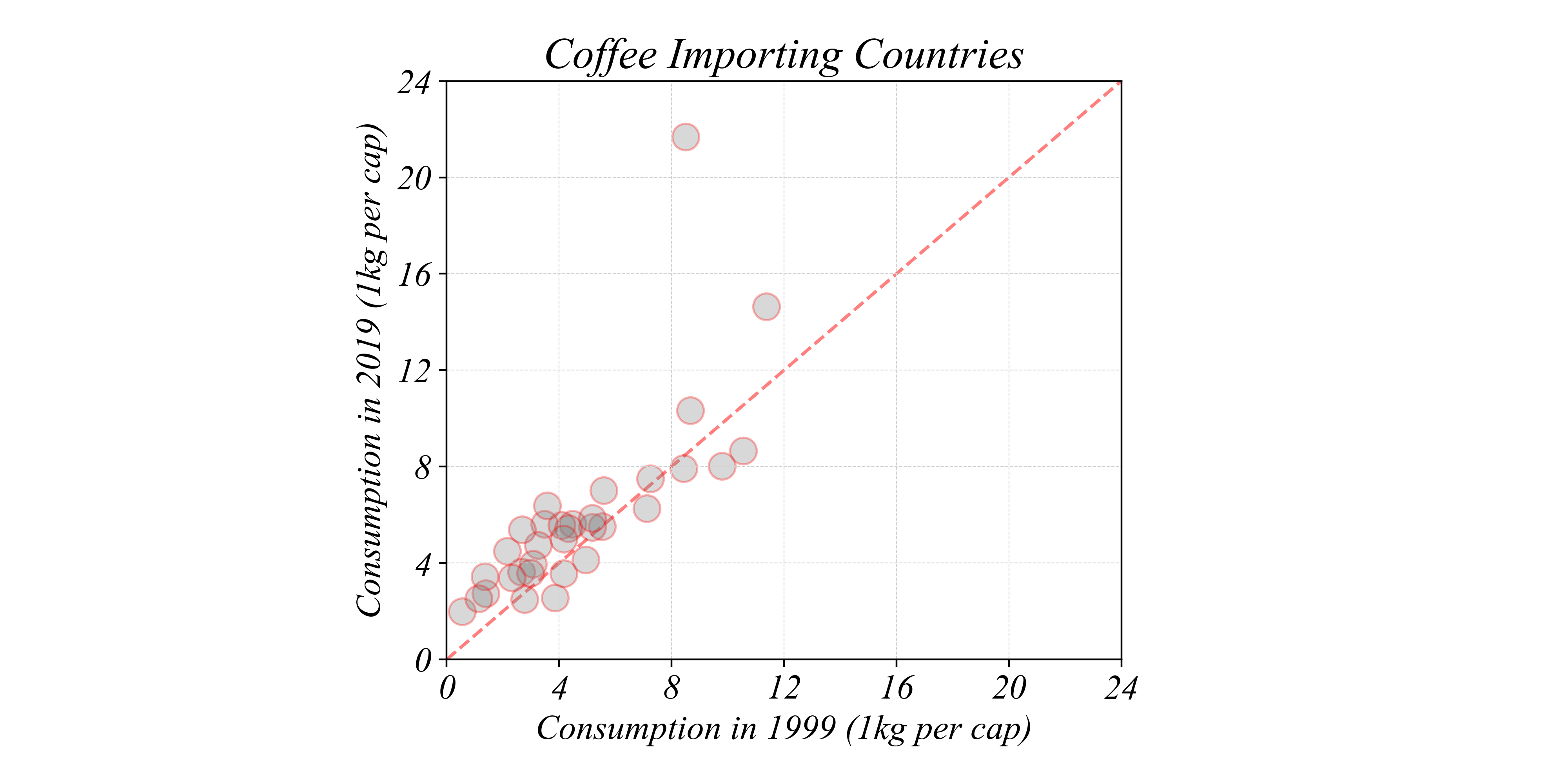
> a 45 degree line shows all the possible points with no change
Panel Data: Relationships Between Years
How many countries increased their coffee consumption between 1999 and 2019?

> points above the line increased
Panel Data: Relationships Between Years
How many countries decreased their coffee consumption between 1999 and 2019?
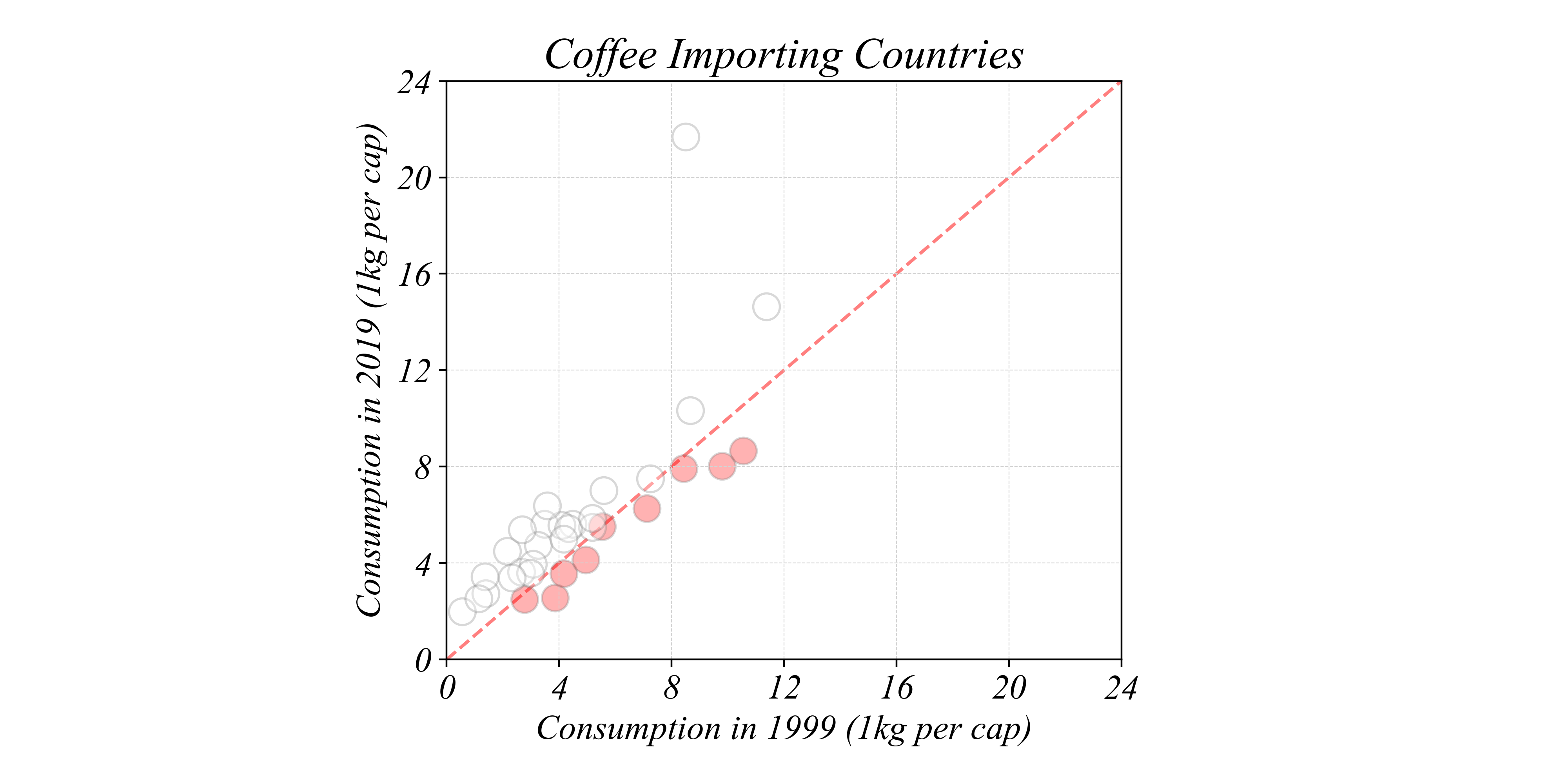
> points below the line decreased
Panel Data: Relationships Between Years
Does the data confirm that the world is drinking more coffee?

> we can use colors to visualize both increases and decreases
Exercise 1.4 | Scatterplots
Is the world drinking more coffee?
We’re going to use a scatterplot to visually examine how countries’ coffee consumption changed between 1999 and 2019.
- Data:
Coffee_Per_Cap.csv
Exercise 1.4 | Scatterplots
Is the world drinking more coffee?
Exercise 1.4 | Scatterplots
Is the world drinking more coffee?

Part 1.4 | Panel Data Using Scatterplots
Summary
- Multi-Boxplots can help visualize changes in the distribution, but cannot track individual changes.
- Scatterplots can show how repeated observations change through time within a single unit.
- A 45 degree line and colors can help visually communicate changes.